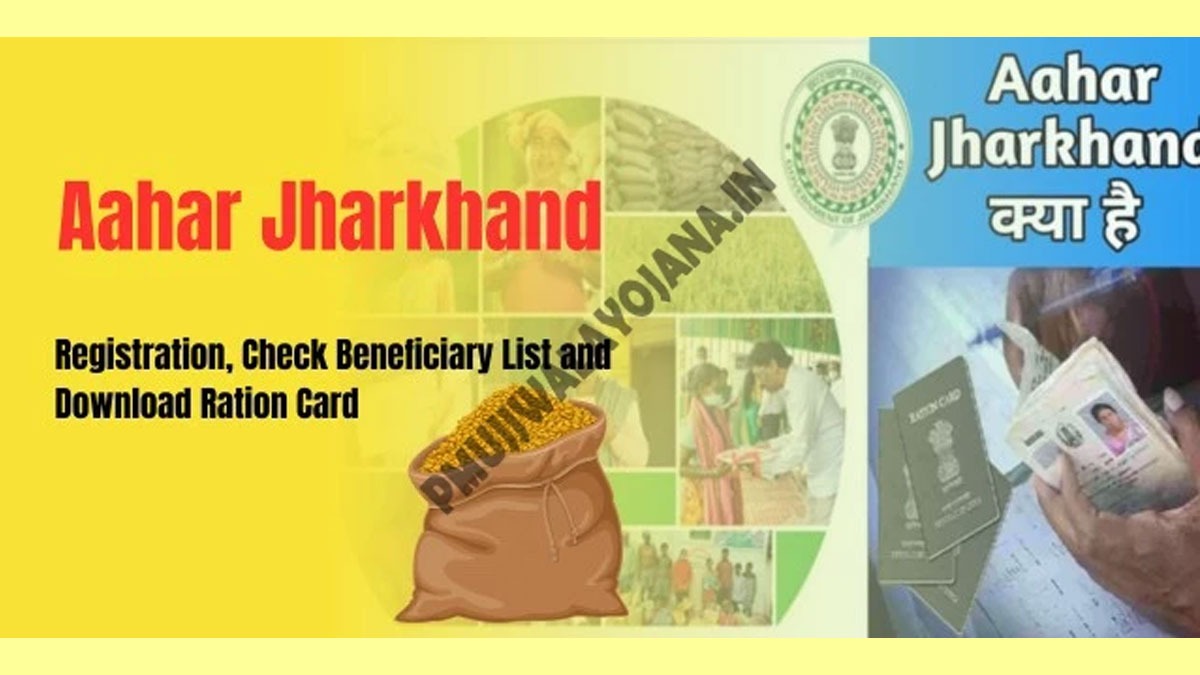Aahar Jharkhand is the official Public Distribution System (PDS) portal run by the Jharkhand Government that helps you get subsidized food grains and other essentials easily. Whether you already have a ration card in Jharkhand or want to apply for one, this platform lets you register, check beneficiary lists, and download your ration card online. All families in Jharkhand are grouped as Above Poverty Line (APL), Below Poverty Line (BPL), or Antyodaya Anna Yojana (AAY) beneficiaries to make sure food reaches the right people at affordable prices.
Overview of Aahar Jharkhand
The Aahar Jharkhand portal is created by the Department of Food, Public Distribution and Consumer Affairs. Its main goal is to provide fair and easy access to food grains and basic commodities to eligible residents at lower prices. You can apply for a new ration card, renew an existing one, or check your application status from home, avoiding long queues and paperwork.
It also helps reduce corruption and food wastage by making the food distribution system more clear and efficient across Jharkhand. Besides supplying food, this platform supports nutritional needs and improves public health, especially for people in poorer economic groups and remote rural areas.
Also Read: nfsa.gov.in Ration Card List
Aahar Jharkhand (PDS) Summary
| Article Name | Aahar Jharkhand (PDS) |
| Launched By | Government of Jharkhand |
| Issued By | Department of Food, Public Distribution and Consumer Affairs |
| Type | Public Distribution System (PDS) |
| Objective | Make sure food security by providing subsidized food grains to eligible residents |
| Beneficiaries | AAY, Priority Household (PHH), APL, BPL families |
| Provided Commodities | Rice, Wheat, Sugar, Kerosene |
| Benefits | Subsidized food grains making food affordable for at-risk populations |
| Eligibility | Must be Jharkhand resident with a valid ration card and meet income criteria |
| Ration Card Usage | Get subsidized food grains, government schemes, and use as identity proof |
| Access | Online applications, renewals and info for convenience and clarity |
| Application Mode | Online through Aahar Portal |
| Official Website | Aahar Jharkhand Portal |
Types of Ration Cards
- Antyodaya Anna Yojana (AAY): Provides 35 kg monthly subsidized food grains to the poorest families.
- Below Poverty Line (BPL): Low-income families get subsidized food through PDS.
- Above Poverty Line (APL): Families above poverty line with limited or no subsidies.
- Priority Household (PHH): Under NFSA, households receive 5 kg food grains per person each month.
Documents Needed for Ration Card Application
- Aadhaar Card
- Proof of Address
- Bank Passbook
- Income Certificate
- Ration Card Surrender Receipt (if applicable)
- Identity proof of all family members
- Passport-sized photo
Who Can Apply?
- Must live in Jharkhand.
- Must meet income-based category (APL, BPL, AAY, PHH).
- Families without government jobs or high income usually qualify.
- All family members must be included in the application.
How to Register Online for Aahar Jharkhand Ration Card
Follow these easy steps to apply online:
- Visit the Official Aahar Jharkhand Website.
- Click on “Register to apply for Ration Card” under the “Green Card” section.
- Fill the ERCMS Registration Form with your details like name (English and Hindi), father’s name, date of birth, mobile number, Aadhaar number, gender, category, card type, district, block, panchayat, and village.
- Upload all required documents and tick the consent box.
- Click “Register” to finish the application.
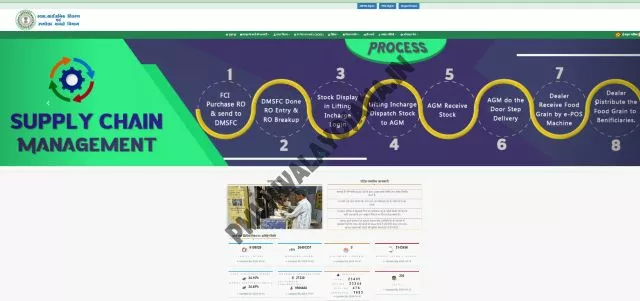
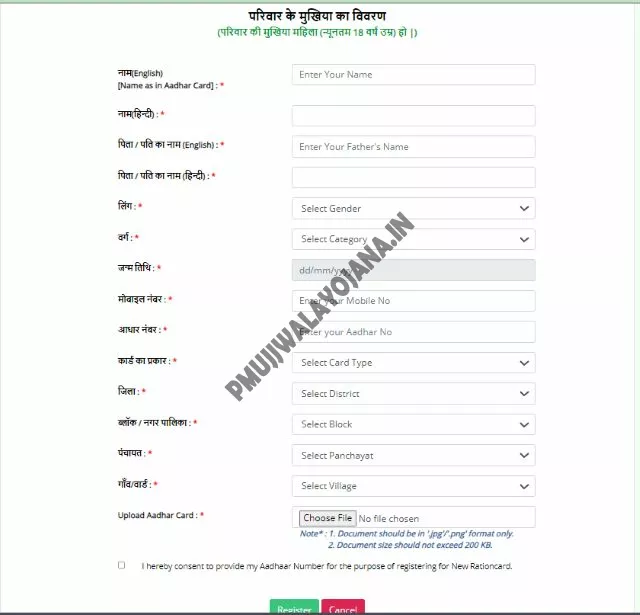
How to Search Ration Card Details
- Go to the official Aahar Jharkhand website.
- Click “Ration card details” under “Beneficiary card details.”
- Select your district, block, card type, and either village/ward or dealer.
- Enter your ration card number and captcha code.
- Click “Submit” to see your ration card details.
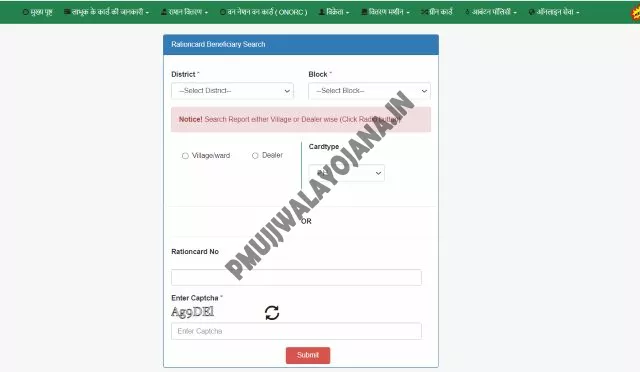
Check Your Ration Card Application Status
- Visit the official Aahar website.
- Click “Check Application Status” under the “Green Card” section.
- Enter your ration card number or acknowledgment number and the captcha code.
- Click “Search” to view your application status.
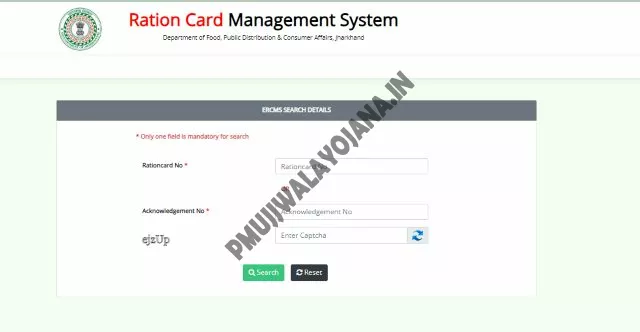
Download the Jharkhand Ration Card List
- Open the official website.
- Click “Eligibility List (Monthly)” under “Beneficiary card details.”
- Choose your district, block, dealer, card type, month, and year.
- Enter the captcha code and click “Submit.”
- The list will appear on your screen. You can download or print it for reference.
Contact Jharkhand PDS Help
For any questions or help, call the helpline number: 18003456598
Frequently Asked Questions (FAQs)
What is a ration card?
A ration card is an official document that helps you buy food grains and other important items at low prices from the government.
Who can get a ration card?
Residents of Jharkhand who meet income and other government-set rules can apply.
What types of ration cards exist?
They include Antyodaya Anna Yojana (AAY) for the poorest families, Below Poverty Line (BPL), Above Poverty Line (APL), and Priority Household (PHH) cards.
How do I apply for a ration card?
You can apply online at the official Aahar Jharkhand portal or at local government offices.
What documents do I need?
Aadhaar card, proof of address, income certificate, photos, and identity proofs of all family members.
How do I know if my ration card application is approved?
Check your application status on the official website using your ration card or acknowledgment number.
Aahar Jharkhand makes it easy for you to get the food support you need with just a few simple steps online. If you qualify, don’t forget to apply or check your details through this useful service.
